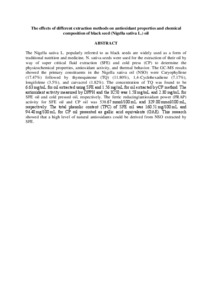Citation
Mohammed, Nameer Khairullah and Abd. Manap, Mohd Yazid and Chin, Ping Tan and Muhialdin, Belal J. and Alhelli, Amaal M. and Meor Hussin, Anis Shobirin
(2015)
The effects of different extraction methods on antioxidant properties and chemical composition of black seed (Nigella sativa L.) oil.
Evidence-Based Complementary and Alternative Medicine, 2016.
art. no. 6273817.
ISSN 1741-427X; ESSN: 1741-4288
Abstract
The Nigella sativa L. popularly referred to as black seeds are widely used as a form of traditional nutrition and medicine. N. sativa seeds were used for the extraction of their oil by way of super critical fluid extraction (SFE) and cold press (CP) to determine the physicochemical properties, antioxidant activity, and thermal behavior. The GC-MS results showed the primary constituents in the Nigella sativa oil (NSO) were Caryophyllene (17.47%) followed by thymoquinone (TQ) (11.80%), 1,4-Cyclohexadiene (7.17%), longifolene (3.5%), and carvacrol (1.82%). The concentration of TQ was found to be 6.63 mg/mL for oil extracted using SFE and 1.56 mg/mL for oil extracted by CP method. The antioxidant activity measured by DPPH and the IC50 was 1.58 mg/mL and 2.30 mg/mL for SFE oil and cold pressed oil, respectively. The ferric reducing/antioxidant power (FRAP) activity for SFE oil and CP oil was 538.67 mmol/100 mL and 329.00 mmol/100 mL, respectively. The total phenolic content (TPC) of SFE oil was 160.51 mg/100 mL and 94.40 mg/100 mL for CP oil presented as gallic acid equivalents (GAE). This research showed that a high level of natural antioxidants could be derived from NSO extracted by SFE.
Download File
![[img]](http://psasir.upm.edu.my/46579/1.hassmallThumbnailVersion/The%20effects%20of%20different%20extraction%20methods%20on%20antioxidant%20properties%20and%20chemical%20composition%20of%20black%20seed%20%28Nigella%20sativa%20L.%29%20oil.pdf)  Preview |
|
Text (Abstract)
The effects of different extraction methods on antioxidant properties and chemical composition of black seed (Nigella sativa L.) oil.pdf
Download (106kB)
| Preview
|
|
Additional Metadata
Actions (login required)
 |
View Item |

